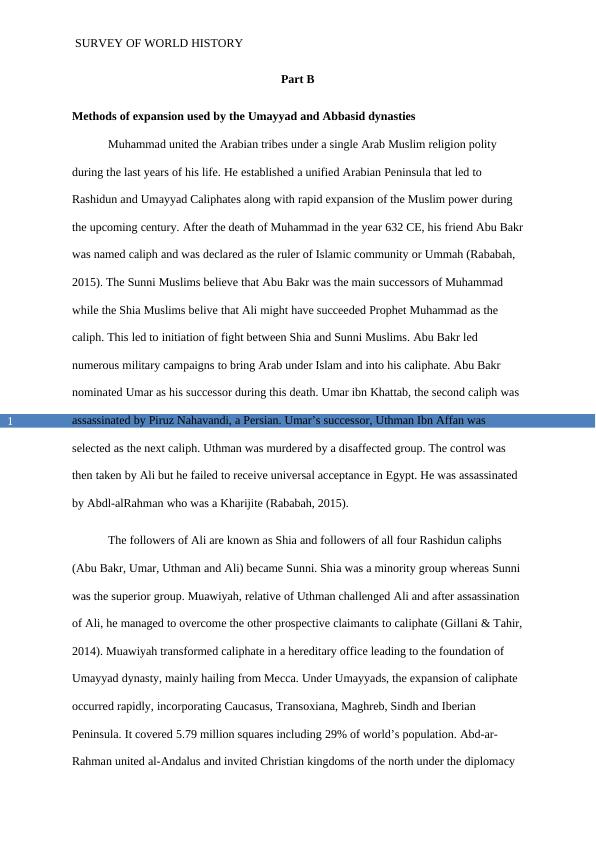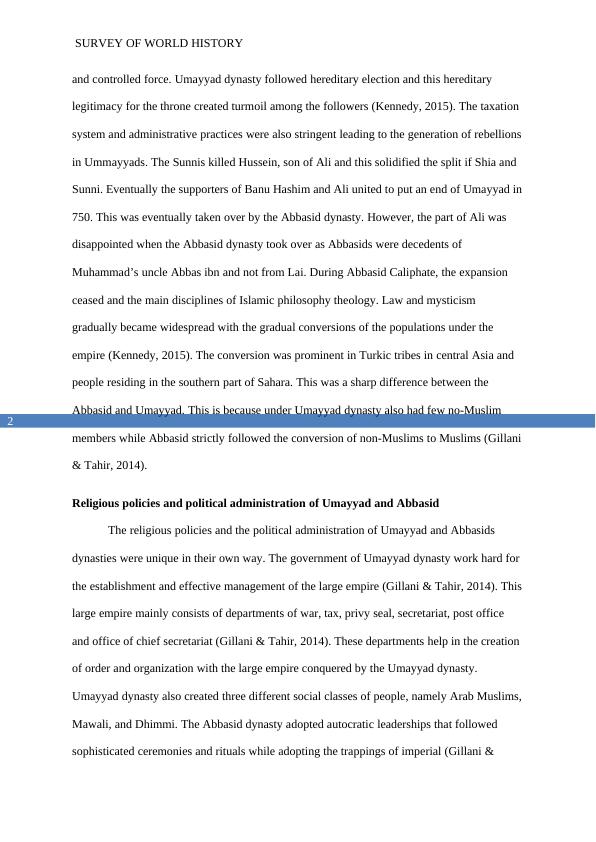Origin and Promotion of Crusades, Methods of Expansion by Umayyad and Abbasid Dynasties, Silk Roads and Epidemic Diseases
6 Pages1824 Words266 Views
Added on 2022-11-28
About This Document
This document discusses the origin and promotion of Crusades, methods of expansion used by Umayyad and Abbasid dynasties, and the role of Silk Roads in the spread of epidemic diseases. It provides insights into the historical, religious, and political aspects of these topics.
Origin and Promotion of Crusades, Methods of Expansion by Umayyad and Abbasid Dynasties, Silk Roads and Epidemic Diseases
Added on 2022-11-28
ShareRelated Documents
Running head: SURVEY OF WORLD HISTORY
Part A
Origin of Crusades
The Crusades were series of religious wars that were sanctioned under the Latin
Church during the medieval era. The commonly known Crusades were the campaigns in the
Eastern Mediterranean that aimed to recovering the Holy Land from the reign of Muslim
turks (Kedar, 2014). However, the term Crusades was also applicable to other campaigns
sanctioned to church. The origin of Crusades did not occur within one day or due to an
outcome of any particular event. Numerous factors paved the way for the generation of
social, political, religious and economic environment facilitating the Crusading spirit in
Europe. Although the overall enthusiasm for crusading cooled periodically, its response once
again revived in the Middle Eastern part of the world (Jotischky, 2016).
Promotion of Crusades
During the last few decades, Crusades have become one of the significant areas in the
history that deemed enormous curiosity. The first Crusade was called in 1095 November by
Pope Urban II in Clermont, central France. Urban is said to be responsible for promoting
spiritual well-being of his flock and crusade help in presenting an opportunity to cease the
endless exploration and in-fighting of the sinful knights of the Western Europe over weak
men (Bird 2017). Urban viewed the campaign as a chance for the knights to re-direct their
energies towards a spiritual meritorious act like recovery of holy city of Jerusalem from
Islam. In return to this, the knights will earn mercy for their sins, provided they had confessed
the same (Bird 2017).
Part A
Origin of Crusades
The Crusades were series of religious wars that were sanctioned under the Latin
Church during the medieval era. The commonly known Crusades were the campaigns in the
Eastern Mediterranean that aimed to recovering the Holy Land from the reign of Muslim
turks (Kedar, 2014). However, the term Crusades was also applicable to other campaigns
sanctioned to church. The origin of Crusades did not occur within one day or due to an
outcome of any particular event. Numerous factors paved the way for the generation of
social, political, religious and economic environment facilitating the Crusading spirit in
Europe. Although the overall enthusiasm for crusading cooled periodically, its response once
again revived in the Middle Eastern part of the world (Jotischky, 2016).
Promotion of Crusades
During the last few decades, Crusades have become one of the significant areas in the
history that deemed enormous curiosity. The first Crusade was called in 1095 November by
Pope Urban II in Clermont, central France. Urban is said to be responsible for promoting
spiritual well-being of his flock and crusade help in presenting an opportunity to cease the
endless exploration and in-fighting of the sinful knights of the Western Europe over weak
men (Bird 2017). Urban viewed the campaign as a chance for the knights to re-direct their
energies towards a spiritual meritorious act like recovery of holy city of Jerusalem from
Islam. In return to this, the knights will earn mercy for their sins, provided they had confessed
the same (Bird 2017).

1
SURVEY OF WORLD HISTORY
Part B
Methods of expansion used by the Umayyad and Abbasid dynasties
Muhammad united the Arabian tribes under a single Arab Muslim religion polity
during the last years of his life. He established a unified Arabian Peninsula that led to
Rashidun and Umayyad Caliphates along with rapid expansion of the Muslim power during
the upcoming century. After the death of Muhammad in the year 632 CE, his friend Abu Bakr
was named caliph and was declared as the ruler of Islamic community or Ummah (Rababah,
2015). The Sunni Muslims believe that Abu Bakr was the main successors of Muhammad
while the Shia Muslims belive that Ali might have succeeded Prophet Muhammad as the
caliph. This led to initiation of fight between Shia and Sunni Muslims. Abu Bakr led
numerous military campaigns to bring Arab under Islam and into his caliphate. Abu Bakr
nominated Umar as his successor during this death. Umar ibn Khattab, the second caliph was
assassinated by Piruz Nahavandi, a Persian. Umar’s successor, Uthman Ibn Affan was
selected as the next caliph. Uthman was murdered by a disaffected group. The control was
then taken by Ali but he failed to receive universal acceptance in Egypt. He was assassinated
by Abdl-alRahman who was a Kharijite (Rababah, 2015).
The followers of Ali are known as Shia and followers of all four Rashidun caliphs
(Abu Bakr, Umar, Uthman and Ali) became Sunni. Shia was a minority group whereas Sunni
was the superior group. Muawiyah, relative of Uthman challenged Ali and after assassination
of Ali, he managed to overcome the other prospective claimants to caliphate (Gillani & Tahir,
2014). Muawiyah transformed caliphate in a hereditary office leading to the foundation of
Umayyad dynasty, mainly hailing from Mecca. Under Umayyads, the expansion of caliphate
occurred rapidly, incorporating Caucasus, Transoxiana, Maghreb, Sindh and Iberian
Peninsula. It covered 5.79 million squares including 29% of world’s population. Abd-ar-
Rahman united al-Andalus and invited Christian kingdoms of the north under the diplomacy
SURVEY OF WORLD HISTORY
Part B
Methods of expansion used by the Umayyad and Abbasid dynasties
Muhammad united the Arabian tribes under a single Arab Muslim religion polity
during the last years of his life. He established a unified Arabian Peninsula that led to
Rashidun and Umayyad Caliphates along with rapid expansion of the Muslim power during
the upcoming century. After the death of Muhammad in the year 632 CE, his friend Abu Bakr
was named caliph and was declared as the ruler of Islamic community or Ummah (Rababah,
2015). The Sunni Muslims believe that Abu Bakr was the main successors of Muhammad
while the Shia Muslims belive that Ali might have succeeded Prophet Muhammad as the
caliph. This led to initiation of fight between Shia and Sunni Muslims. Abu Bakr led
numerous military campaigns to bring Arab under Islam and into his caliphate. Abu Bakr
nominated Umar as his successor during this death. Umar ibn Khattab, the second caliph was
assassinated by Piruz Nahavandi, a Persian. Umar’s successor, Uthman Ibn Affan was
selected as the next caliph. Uthman was murdered by a disaffected group. The control was
then taken by Ali but he failed to receive universal acceptance in Egypt. He was assassinated
by Abdl-alRahman who was a Kharijite (Rababah, 2015).
The followers of Ali are known as Shia and followers of all four Rashidun caliphs
(Abu Bakr, Umar, Uthman and Ali) became Sunni. Shia was a minority group whereas Sunni
was the superior group. Muawiyah, relative of Uthman challenged Ali and after assassination
of Ali, he managed to overcome the other prospective claimants to caliphate (Gillani & Tahir,
2014). Muawiyah transformed caliphate in a hereditary office leading to the foundation of
Umayyad dynasty, mainly hailing from Mecca. Under Umayyads, the expansion of caliphate
occurred rapidly, incorporating Caucasus, Transoxiana, Maghreb, Sindh and Iberian
Peninsula. It covered 5.79 million squares including 29% of world’s population. Abd-ar-
Rahman united al-Andalus and invited Christian kingdoms of the north under the diplomacy

2
SURVEY OF WORLD HISTORY
and controlled force. Umayyad dynasty followed hereditary election and this hereditary
legitimacy for the throne created turmoil among the followers (Kennedy, 2015). The taxation
system and administrative practices were also stringent leading to the generation of rebellions
in Ummayyads. The Sunnis killed Hussein, son of Ali and this solidified the split if Shia and
Sunni. Eventually the supporters of Banu Hashim and Ali united to put an end of Umayyad in
750. This was eventually taken over by the Abbasid dynasty. However, the part of Ali was
disappointed when the Abbasid dynasty took over as Abbasids were decedents of
Muhammad’s uncle Abbas ibn and not from Lai. During Abbasid Caliphate, the expansion
ceased and the main disciplines of Islamic philosophy theology. Law and mysticism
gradually became widespread with the gradual conversions of the populations under the
empire (Kennedy, 2015). The conversion was prominent in Turkic tribes in central Asia and
people residing in the southern part of Sahara. This was a sharp difference between the
Abbasid and Umayyad. This is because under Umayyad dynasty also had few no-Muslim
members while Abbasid strictly followed the conversion of non-Muslims to Muslims (Gillani
& Tahir, 2014).
Religious policies and political administration of Umayyad and Abbasid
The religious policies and the political administration of Umayyad and Abbasids
dynasties were unique in their own way. The government of Umayyad dynasty work hard for
the establishment and effective management of the large empire (Gillani & Tahir, 2014). This
large empire mainly consists of departments of war, tax, privy seal, secretariat, post office
and office of chief secretariat (Gillani & Tahir, 2014). These departments help in the creation
of order and organization with the large empire conquered by the Umayyad dynasty.
Umayyad dynasty also created three different social classes of people, namely Arab Muslims,
Mawali, and Dhimmi. The Abbasid dynasty adopted autocratic leaderships that followed
sophisticated ceremonies and rituals while adopting the trappings of imperial (Gillani &
SURVEY OF WORLD HISTORY
and controlled force. Umayyad dynasty followed hereditary election and this hereditary
legitimacy for the throne created turmoil among the followers (Kennedy, 2015). The taxation
system and administrative practices were also stringent leading to the generation of rebellions
in Ummayyads. The Sunnis killed Hussein, son of Ali and this solidified the split if Shia and
Sunni. Eventually the supporters of Banu Hashim and Ali united to put an end of Umayyad in
750. This was eventually taken over by the Abbasid dynasty. However, the part of Ali was
disappointed when the Abbasid dynasty took over as Abbasids were decedents of
Muhammad’s uncle Abbas ibn and not from Lai. During Abbasid Caliphate, the expansion
ceased and the main disciplines of Islamic philosophy theology. Law and mysticism
gradually became widespread with the gradual conversions of the populations under the
empire (Kennedy, 2015). The conversion was prominent in Turkic tribes in central Asia and
people residing in the southern part of Sahara. This was a sharp difference between the
Abbasid and Umayyad. This is because under Umayyad dynasty also had few no-Muslim
members while Abbasid strictly followed the conversion of non-Muslims to Muslims (Gillani
& Tahir, 2014).
Religious policies and political administration of Umayyad and Abbasid
The religious policies and the political administration of Umayyad and Abbasids
dynasties were unique in their own way. The government of Umayyad dynasty work hard for
the establishment and effective management of the large empire (Gillani & Tahir, 2014). This
large empire mainly consists of departments of war, tax, privy seal, secretariat, post office
and office of chief secretariat (Gillani & Tahir, 2014). These departments help in the creation
of order and organization with the large empire conquered by the Umayyad dynasty.
Umayyad dynasty also created three different social classes of people, namely Arab Muslims,
Mawali, and Dhimmi. The Abbasid dynasty adopted autocratic leaderships that followed
sophisticated ceremonies and rituals while adopting the trappings of imperial (Gillani &

End of preview
Want to access all the pages? Upload your documents or become a member.
Related Documents
Divisions over Muslims - World Religionlg...
|3
|411
|19
